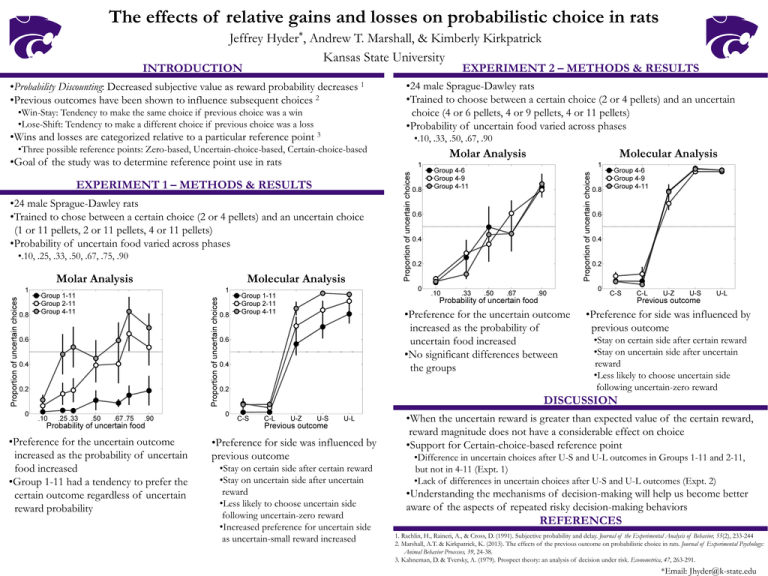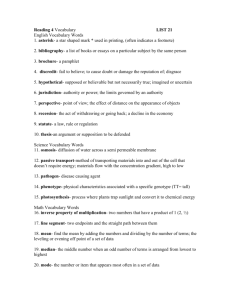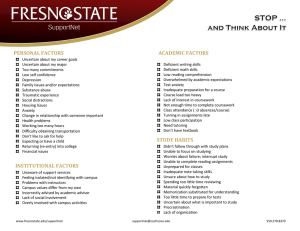The effects of relative gains and losses on probabilistic... Jeffrey Hyder , Andrew T. Marshall, & Kimberly Kirkpatrick
advertisement

The effects of relative gains and losses on probabilistic choice in rats Jeffrey * Hyder , Andrew T. Marshall, & Kimberly Kirkpatrick Kansas State University EXPERIMENT 2 – METHODS & RESULTS INTRODUCTION •Probability Discounting: Decreased subjective value as reward probability decreases 2 •Previous outcomes have been shown to influence subsequent choices 1 •Win-Stay: Tendency to make the same choice if previous choice was a win •Lose-Shift: Tendency to make a different choice if previous choice was a loss •Wins and losses are categorized relative to a particular reference point 3 •Three possible reference points: Zero-based, Uncertain-choice-based, Certain-choice-based •Goal of the study was to determine reference point use in rats •24 male Sprague-Dawley rats •Trained to choose between a certain choice (2 or 4 pellets) and an uncertain choice (4 or 6 pellets, 4 or 9 pellets, 4 or 11 pellets) •Probability of uncertain food varied across phases •.10, .33, .50, .67, .90 Molar Analysis Molecular Analysis •Preference for the uncertain outcome increased as the probability of uncertain food increased •No significant differences between the groups •Preference for side was influenced by previous outcome EXPERIMENT 1 – METHODS & RESULTS •24 male Sprague-Dawley rats •Trained to chose between a certain choice (2 or 4 pellets) and an uncertain choice (1 or 11 pellets, 2 or 11 pellets, 4 or 11 pellets) •Probability of uncertain food varied across phases •.10, .25, .33, .50, .67, .75, .90 Molar Analysis Molecular Analysis •Stay on certain side after certain reward •Stay on uncertain side after uncertain reward •Less likely to choose uncertain side following uncertain-zero reward DISCUSSION •Preference for the uncertain outcome increased as the probability of uncertain food increased •Group 1-11 had a tendency to prefer the certain outcome regardless of uncertain reward probability •Preference for side was influenced by previous outcome •Stay on certain side after certain reward •Stay on uncertain side after uncertain reward •Less likely to choose uncertain side following uncertain-zero reward •Increased preference for uncertain side as uncertain-small reward increased •When the uncertain reward is greater than expected value of the certain reward, reward magnitude does not have a considerable effect on choice •Support for Certain-choice-based reference point •Difference in uncertain choices after U-S and U-L outcomes in Groups 1-11 and 2-11, but not in 4-11 (Expt. 1) •Lack of differences in uncertain choices after U-S and U-L outcomes (Expt. 2) •Understanding the mechanisms of decision-making will help us become better aware of the aspects of repeated risky decision-making behaviors REFERENCES 1. Rachlin, H., Raineri, A., & Cross, D. (1991). Subjective probability and delay. Journal of the Experimental Analysis of Behavior, 55(2), 233-244 2. Marshall, A.T. & Kirkpatrick, K. (2013). The effects of the previous outcome on probabilistic choice in rats. Journal of Experimental Psychology: Animal Behavior Processes, 39, 24-38. 3. Kahneman, D. & Tversky, A. (1979). Prospect theory: an analysis of decision under risk. Econometrica, 47, 263-291. *Email: Jhyder@k-state.edu






